Q1. Which of the following languages flourished till about Alexander’s time (336–323 BCE)?
(A) Sumerian
(B) Akkadian
(C) Aramaic
(D) Hebrew
Answer: (C) Aramaic
Explanation: Aramaic was the main language of administration and trade in the Near East till Alexander’s invasion. It continued to flourish with regional variations until replaced by Greek under the Hellenistic rulers.
Q2. Coin named ‘Solidus’ was introduced by which of the following rulers?
(A) Augustus
(B) Tiberius
(C) Constantine
(D) Justinian
Answer: (C) Constantine
Explanation: Emperor Constantine introduced the gold coin “Solidus” in the 4th century CE to stabilize Roman currency. It became the standard coin of the Byzantine Empire for centuries.
Q3. With which title was Temujin proclaimed the ‘Great Khan of the Mongols’ by ‘Kuriltai’?
(A) Oceanic Khan
(B) Alamgir
(C) Shahenshah
(D) Sultan
Answer: (A) Oceanic Khan
Explanation: Temujin was proclaimed “Chinggis Khan” (meaning Oceanic or Universal Ruler) by the tribal assembly (Kuriltai) in 1206 CE, marking the foundation of the Mongol Empire.
Q4. Identify the picture and choose the correct answer –
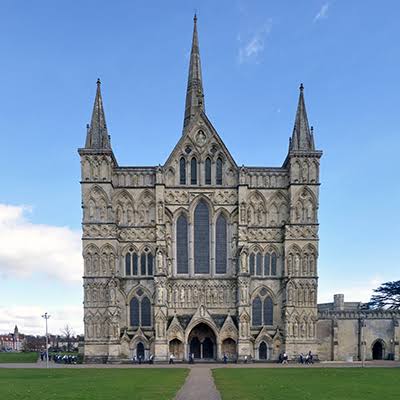
(A) Nemour’s Castle
(B) Hener Castle of England
(C) St. Michael’s Benedictine abbey, England
(D) Salisbury Cathedral, England
Answer: (D) Salisbury Cathedral, England
Explanation: The structure represents Gothic architecture, characterized by pointed arches and tall spires, typical of the Salisbury Cathedral in England (built in the 13th century).
Alternate for visually impaired:
The word England comes from “Angle Land”, referring to the Angles, a Germanic tribe.
(A) English land
(B) Normandy
(C) English Channel
(D) Angle Land
Answer: (D) Angle Land
Q5. The earliest known temple of Mesopotamia was a small shrine made of –
(A) Unbaked bricks
(B) Baked bricks
(C) Wood
(D) Marbel
Answer: (A) Unbaked bricks
Explanation: The first temples in Mesopotamia were simple shrines constructed from unbaked mud bricks, later evolving into large ziggurats made of baked bricks.
Q6. Consider the following statements about Augustus and choose the correct option:
(i) He established the regime called ‘Principate’ in 27 BCE.
(ii) Augustus was the sole ruler and the only real source of authority.
(iii) ‘Augustan Age’ is remembered for peace.
(iv) Augustus was an absolute ruler.
Options:
(A) Only (i) and (ii) are correct.
(B) Only (ii) and (iii) are correct.
(C) Only (i), (ii) and (iii) are correct.
(D) Only (ii), (iii) and (iv) are correct.
Answer: (C) Only (i), (ii), and (iii) are correct.
Explanation: Augustus established the Principate, maintaining the illusion of republican rule. His reign (27 BCE–14 CE) brought long peace (Pax Romana), but he avoided openly autocratic titles.
Q7. Assertion (A) & Reason (R):
A: Administrators recruited by Genghis Khan were sometimes moved around, like Chinese secretaries deployed in Iran and Persians in China.
R: They helped integrate distant dominions and used their skills to reduce nomadic harshness on settled life.
Options:
(A) Both (A) and (R) are true and (R) is correct explanation of (A).
(B) Both (A) and (R) are true but (R) is not a correct explanation of (A).
(C) (A) is true and (R) is false.
(D) (A) is false and (R) is true.
Answer: (A) Both (A) and (R) are true and (R) is the correct explanation of (A).
Explanation: Genghis Khan’s policy of cross-posting administrators promoted efficient governance and cultural exchange across the vast Mongol Empire.
Q8. In 13th century, they moved from place to place preaching and living on charity.
They used to move from place to place preaching to the people and living on charity.
(A) Pope
(B) Bishop
(C) Friars
(D) Lord
Answer: (C) Friars
Explanation: The Friars (e.g., Franciscans, Dominicans) were mendicant monks who preached among common people rather than living in monasteries.
Q9. Which man of the southern marshes released Babylonia from Assyrian domination?
(A) Nabopolasiar
(B) Assurbanipal
(C) Gilgamesh
(D) Enmerkar
Answer: (A) Nabopolassar
Explanation: Nabopolassar (625–605 BCE), founder of the Neo-Babylonian Empire, defeated the Assyrians and reestablished Babylonian independence.
Q10. Which one of the following statements is not correct, with reference to the slave system prevailed in the Roman Empire?
(A) Slaves were seen like an investment.
(B) Slave breeding was a practice to increase the number of slaves.
(C) On one hand, if the Roman upper classes were often brutal towards their slaves, ordinary people did sometimes show much more compassion.
(D) Christianity when it emerged and triumphed as the state religion seriously challenged this institution of slavery.
Answer: (D) Christianity seriously challenged the institution of slavery.
Explanation: Christianity did not initially abolish or strongly challenge slavery; it persisted even after Christianity became the state religion.
Q11. It was a compilation of customary traditions of Mongol tribes, called the ‘Legal Code’ of Genghis Khan.
(A) Courier system
(B) Gerege
(C) Yasa
(D) Qubcur
Answer: (C) Yasa
Explanation: The Yasa was a secret legal code that outlined laws, administrative orders, and military rules established by Genghis Khan for his empire.
Q12. Which Mongol ruler formed the ‘Golden Horde’ and ruled the Russian steppes?
(A) Jochi
(B) Chaghatai
(C) Ogodei
(D) Toluy
Answer: (A) Jochi
Explanation: Jochi, eldest son of Genghis Khan, established the Golden Horde, which ruled over the Russian and western steppe regions.
13. Match the following geographical features of Mesopotamia:
| Direction | Feature |
|---|---|
| (i) North-East | (d) Tributaries of Tigris into Iranian mountains |
| (ii) North | (b) Undulating plains rising to forested mountains |
| (iii) East | (c) Deserted area where first cities and writing emerged |
| (iv) South | (a) Stretch of upland called a steppe |
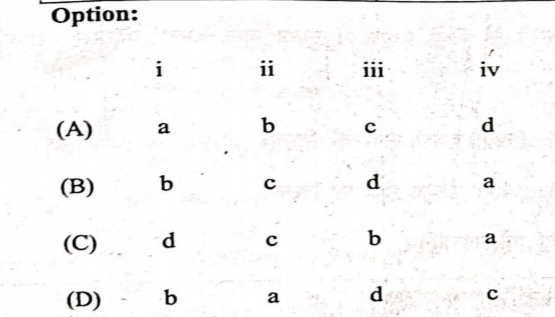
Answer: (C) i–d, ii–b, iii–c, iv–a
Explanation: This arrangement correctly matches Mesopotamia’s regional geography with its physical features and early city sites.
Q14. From which place were over five million amphorae remains found?
(A) Spain
(B) Campania
(C) Monte Testaccio
(D) Byzacium
Answer: (C) Monte Testaccio
Explanation: Monte Testaccio in Rome is a man-made hill of broken amphorae (wine jars)—evidence of large-scale Roman trade and storage.
Q15. “In the spirit of Ganghis Khan’s that the grandson _____warned the French ruler_____that,” In heaven there is only one Eternal Sky and on Earth only one lord, Genghis Khan.”
(A) Batu, Louis 1
(B)Mongke, Louis IX
(C) Qublai, Louis XI
(D) Berke, Louis XIV
Answer: (B) Mongke to Louis IX
Explanation: Mongke Khan (grandson of Genghis Khan) wrote to Louis IX of France, asserting Mongol universal sovereignty.
Q16. Who among the following was one of the earliest scholars who worked on feudalism?
(A) Mare Bloch
(B) Karl Marx
(C) St. Michael
(D) Geoffrey Chaucer
Answer: (A) Marc Bloch
Explanation: Marc Bloch, a French historian, authored “Feudal Society” and pioneered the study of feudalism in medieval Europe.
Q17. From which community were the kings of Mari related?
(A) Assyrians
(B) Akkadians
(C) Amorites
(D) Aramaeans
Answer: (C) Amorites
Explanation: The rulers of Mari in northern Mesopotamia belonged to the Amorite tribe, who settled and ruled the region around 2000 BCE.
Q18. The ‘Papyrus’, a reed-like plant, grew along which river?
(A) Bank of Nile River
(B) Bank of Tigris River
(C) Bank of Eupharatus River
(D) Bank of Denub River
Answer: (A) Bank of Nile River
Explanation: Papyrus, found along the Nile, was used by Egyptians to make writing material, later adopted in the Greco-Roman world.
Q19. Identify the person on the basis of given information –
He was a descendants of Genghis Khan’s youngest son Toley.
He warned family members and other generals to avoid pillaging the peasantry because it did not lead to the a stable and prosperous realms.
Options:
(A) Qublai khan
(B) Mongke
(C) Ghazan Khan
(D) Jochi
Answer: (C) Ghazan Khan
Explanation: Ghazan Khan, ruler of the Ilkhanate (Iran), was a reformer who sought stability, promoted Islam, and discouraged exploitation of peasants.
Q20. In which Mesopotamian city was the famous sculpture ‘Warka Head’ made?
(A) Ur
(B) Uruk
(C) Mari
(D) Babylon
Answer: (B) Uruk
Explanation: The Warka Head, one of the earliest known realistic sculptures (c. 3000 BCE), was discovered in Uruk (modern Warka, Iraq).
Q21. The term ‘barbarian’ is derived from which language?
(A) Greek
(B) Latin
(C) Hebrew
(D) Sumerian
Answer: (A) Greek
Explanation: The word “barbarian” comes from the Greek barbaros, used to describe non-Greek speakers whose language sounded like “bar-bar” to Greeks.
SECTION B ( SHORT ANSWER TYPE QUESTIONS)
(3 Mark Question)
Q.22 ‘However rich the food resources of Mesopotamia, its mineral resources were few.’ Substantiate the statement with the help of examples.
Ans:
- Mesopotamia had abundant agricultural resources due to fertile alluvial soil, but lacked essential minerals such as metals, stones, and wood.
- Copper was imported from Oman, tin from Iran and Afghanistan, and precious stones from the Indus Valley region.
- This shortage of minerals led to the growth of long-distance trade, making Mesopotamia a hub of commercial activity with neighboring regions.
OR
‘It was natural fertility and high levels of food production that were the causes of early urbanisation.’ Explain.
Ans:
- The fertile plains between the Tigris and Euphrates rivers supported high agricultural yields.
- Surplus food encouraged population growth and allowed people to specialize in crafts, trade, and administration.
- This specialization and surplus exchange led to the development of towns and cities like Ur, Uruk, and Eridu — marking the beginning of urbanization.
Q.23 Explain how the courier system started by Genghis Khan was highly reliable and surprising.
Ans:
- Genghis Khan established an efficient relay system called the Yam — a network of relay stations with fresh horses and riders.
- Couriers could travel long distances rapidly, carrying royal messages and orders across the vast Mongol Empire.
- This system ensured safety, speed, and reliability — messages could travel thousands of miles within a few days, which was highly advanced for that era.
Q.24 Describe briefly the cultural diversity of the Roman Empire which was reflected in many ways and at many levels.
Ans:
- The Roman Empire covered regions from Britain to Egypt, encompassing people of different languages, religions, and customs.
- Local traditions and gods were often respected and integrated into Roman culture, leading to a mix of Roman and provincial influences.
- Roman architecture, art, and literature reflected this blend — for example, Greek art influenced Roman sculpture and design.
Q.25 Explain to whom and on what basis the responsibility of governing the newly conquered people was handed over by Genghis Khan.
Ans:
- Genghis Khan distributed administrative responsibilities among his trusted family members and loyal generals.
- The basis of governance was merit and loyalty, not lineage or tribe.
- He appointed capable leaders to ensure efficient administration, law enforcement, and regular tax collection in the conquered territories.
Q.26 Discuss for what purposes the cuneiform writing of the Sumerian language was used in Mesopotamia around 2600 BCE.
Ans:
- Cuneiform writing was primarily used for recording trade transactions, land deals, and tax collection.
- It was also used to write down laws, royal inscriptions, and religious hymns.
- Over time, it became a tool for education and literature, with scribes recording myths, epics, and historical events.
Q27. Compare the condition of life of French serfs and Roman slaves.
Answer:
- Freedom and Status:
- Roman slaves were property of their masters and had no personal rights.
- French serfs were not property, but were bound to the land and could not leave without their lord’s permission.
- Work and Duties:
- Slaves worked in households, farms, and mines under harsh control and punishment.
- Serfs cultivated their own small plots and the lord’s demesne, giving a part of produce or labour as rent.
- Possibility of Freedom:
- Some Roman slaves could earn or buy freedom (manumission).
- French serfs gradually gained freedom through payment, royal decrees, or by moving to towns where “town air made them free.”
In summary:
Roman slaves were completely unfree humans, while French serfs were legally bound peasants—oppressed but with limited rights and chances of liberation.
OR
Review with examples, the factors responsible for the slow economic growth of Europe by the beginning of the fourteenth century.
Answer:
- Agricultural Crisis: From the early 14th century, Europe faced declining agricultural productivity due to poor weather, exhausted soils, and shortage of labour.
- Famine and Epidemics: The Great Famine (1315–17) and frequent plagues reduced population drastically, lowering demand and production.
- Wars and Political Instability: Continuous wars such as the Hundred Years’ War (1337–1453) disrupted trade and agriculture, slowing Europe’s overall economic growth.
SECTION-C (Long-Answer Questions – 8 Marks Each)
Q.28 ‘In the Mesopotamian Civilization, the city of Mari apart from being an excellent pastoral area, was unique in terms of trade and prosperity.’ Check the correctness of the statement with suitable examples.
Answer:
- Strategic Location: Mari was situated on the middle Euphrates, serving as a link between southern Mesopotamia and the Mediterranean regions.
- Pastoral Region: Its surrounding region was ideal for animal rearing — sheep, goats, and cattle — supporting both herders and traders.
- Trade Centre: Mari was an important hub for trade in textiles, metals, timber, and agricultural goods with Anatolia, Levant, and other Mesopotamian cities.
- Palace and Administration: Excavations revealed a grand palace with over 260 rooms, indicating a powerful administrative and economic centre.
- Archives and Records: Thousands of clay tablets found at Mari record trade transactions, treaties, and diplomatic correspondence — evidence of its prosperity.
- Cultural Exchange: Mari was a meeting point for various cultural influences — Sumerian, Akkadian, and Amorite traditions.
- Wealth and Urban Life: Prosperity led to large buildings, workshops, and active marketplaces reflecting a thriving urban economy.
- Destruction and Decline: Despite its importance, Mari was later destroyed by Hammurabi of Babylon around 1759 BCE, ending its golden age.
OR
Highlight the facts obtained in the context of urban layout and social structure of Ur city of Mesopotamia after the systematical excavation done in the decades of 1930s.
Answer:
- Planned City: Excavations by Sir Leonard Woolley (1920s–30s) revealed Ur had well-planned streets, drainage systems, and residential blocks.
- Ziggurat: The massive Ziggurat of Ur dedicated to Moon God Nanna stood at the city’s centre — both a religious and administrative hub.
- Residential Patterns: Houses had courtyards, showing social divisions — larger houses for elites, smaller for commoners.
- Burial Sites: The Royal Cemetery contained richly furnished graves, proving existence of an upper ruling class.
- Craft and Trade: Archaeological remains show workshops for metal, pottery, and bead-making; trade links with Indus Valley and Iran.
- Administrative Records: Thousands of cuneiform tablets from Ur detail taxation, land, and labour management.
- Social Hierarchy: Society was stratified — kings and priests at the top, artisans and farmers below, and slaves at the bottom.
- Urban Growth: Ur’s organized layout and monumental buildings represent advanced urbanization during the early Bronze Age.
Q.29
Explain the cultural, religious, and economic changes that occurred in the Roman Empire during 4th century CE to 7th century CE.
Answer:
- Rise of Christianity: After Constantine’s conversion (313 CE), Christianity became the official religion, transforming Roman religious life.
- Decline of Paganism: Traditional Roman gods and temples gradually disappeared as Christianity spread across provinces.
- Division of Empire: The empire split into Eastern (Byzantine) and Western parts; Constantinople became the new capital.
- Economic Decline: Continuous wars and barbarian invasions weakened trade and agriculture, leading to urban decay.
- Shift in Trade: Economic focus moved eastwards toward Constantinople and the Eastern Mediterranean regions.
- Ruralisation: Cities declined; people moved to countryside estates, marking the beginning of feudal tendencies.
- Cultural Transformation: Greek language and culture dominated the East; Latin continued in the West.
- Fall of the West: The Western Roman Empire collapsed by 476 CE, while the Byzantine Empire survived, preserving Roman law and culture.
OR
‘Much more characteristic was the gradual extension of Roman direct rule during early Roman empire.’ Substantiate the statement with examples.
Answer:
- Expansion Policy: Early emperors expanded territories by annexing new provinces through conquests and diplomacy.
- Imperial Governors: Direct rule was established by appointing governors responsible to the emperor, replacing local kings.
- Example of Egypt: After Augustus conquered Egypt (30 BCE), it became a directly ruled imperial province.
- Gaul and Spain: Gradually brought under direct Roman control with military supervision and Roman administration.
- Tax Collection: Uniform tax systems and censuses were introduced in all directly ruled provinces.
- Roman Law: Legal and administrative systems unified diverse regions under Roman law.
- Military Control: Permanent army garrisons in provinces ensured loyalty and protection of imperial interests.
- Cultural Integration: Local elites were given citizenship, blending provincial cultures into Roman identity and strengthening direct imperial authority.
Q.30 Analyse the factors affecting social and economic relations in a feudal society.
Answer:
- Land Ownership: Land was the main source of wealth; lords owned large estates worked by peasants.
- Vassalage System: Nobles (vassals) pledged loyalty and military service to lords in exchange for land (fiefs).
- Manorial System: Peasants worked the lord’s land, paying rent and taxes, forming the economic base of feudal society.
- Hereditary Rights: Both land and status were inherited, creating rigid social hierarchies.
- Limited Trade: Economy was largely agrarian and local; towns were few and small.
- Church Influence: The Church shaped moral and economic life, collecting tithes and owning vast lands.
- Mutual Obligations: Feudal relations were based on mutual duties — protection by lords, service by peasants.
- Technological Stagnation: Limited innovation and isolation slowed economic growth and kept society static.
OR
‘In an economic sense, during ninth and sixteenth century in Europe, feudalism refers to a kind of agricultural production which is based on the relationship between lords and peasants.’ Explain the above statement with reference to ‘Vassalage’ system.
Answer:
- Agrarian Economy: Feudalism was primarily agricultural, centred on the manor, where peasants cultivated the lord’s land.
- Lord–Peasant Relationship: Lords provided protection and land, while peasants offered labour, rent, and produce.
- Vassalage System: Nobles or vassals swore loyalty to powerful lords or kings and received land (fiefs) in return for military service.
- Hierarchy of Power: The system created a chain — king → lord → vassal → peasant — defining all social and economic relations.
- Self-Sufficient Units: Manors produced everything locally; little external trade existed.
- Social Obligations: Feudal duties were fixed by custom — unpaid labour, taxes, and military aid.
- Church Role: The Church supported the feudal order, justifying lordship as divinely sanctioned.
- Decline: Gradual rise of towns, money economy, and centralized monarchies later weakened the vassalage system.
(Source Based Question)
(3×4=12)
- Read the source given below and answer the questions that follow –
‘If my dear lord is slain, his fate I’ll share, If he is hanged, then hang me by his side. If to the stake he goes, with him I’ll burn; And if he’s drowned, then let me drown with him.’ ‘Doon de Mayence a thirteenth-century French poem (to he sung) recounting the adventures of knights.
Q31.1 Knight was which kind of group of people? (1 mark)
Answer: Knights were mounted warriors, part of the feudal warrior aristocracy who fought on horseback and served as the military elite.
Q31.2 What was the land, given by the lord to the knight called? (1 mark)
Answer: The land given to a knight by his lord was called a fief (also called a benefice or fee).
Q31.3 How was the knight linked to his lord? (2 marks)
Answer:
- The knight became a vassal of the lord by performing a ceremony of homage and oath (fealty), promising loyalty and military service.
- In return the lord granted the knight a fief (land) and protection; thus their relationship was based on mutual obligations — service by the knight and reward/protection by the lord.
32.Read the source given below and answer the question that follow –
Estimated Extent of Mongol Destruction
All reports of Genghis Khan’s campaigns agree at the vast number of people killed following the capture of cities that defied his authority. The numbers are staggering: at the capture of Nishapur in 1220, 17,47,000 people were massacred while the toll at Herat in 1222 was 1,600,000 people and at Baghdad in 1258, 800,000. Smaller towns suffered proportionately: Nasa, 70,000 dead; Baihaq district, 70,000; and at Tun in the Kuhistan province, 12,000 individuals were executed.
How did medieval chroniclers arrive at such figures?
Juwaini, the Persian chronicler of the Ilkhans stated that 1,300,000 people were killed in Merv. He reached the figure because it took thirteen days to count the dead and each day they counted 100,000 corpses.
Q32.1 What was Genghis Khan’s initial name? (1)
Answer:
Genghis Khan’s initial name was Temujin.
Q32.2 Why were so many people killed by Ganghis Khan? (1)
Answer:Genghis Khan ordered mass killings to punish cities that resisted his authority and to instill fear among others so that they would surrender without resistance.
Q32.3 How did Juwaini, the persian chronicler estimate the no. of people killed at Merv?(2)
Answer:
- Juwaini stated that it took thirteen days to count the dead after the capture of Merv.
- Each day, they counted around 100,000 corpses, and multiplying that figure (13 × 100,000) led him to estimate 1,300,000 people were killed.
‘Q33.
The famine prevalent for many successive years in many provinces has clearly displayed for men of any understanding the effect of malnutrition in generating illness. The city-dwellers, as it was their custom to collect and store enough grain for the whole of the next year immediately after the harvest, carried off all the wheat, barley, beans and lentils, and left to the peasants various kinds of pulse after taking quite a large proportion of these to the city. After consuming what was left in the course of the winter, the country people had to resort to unhealthy foods in the spring; they ate twigs and shoots of trees and bushes and bulbs and roots of inedible plants…’
Galen, On Good and Bad Diet.
Q33.1 Who is the writer of the above source? (1)
Answer:
The writer of the source is Galen, a famous Greek physician and philosopher.
Q33.2 Why were people getting illness in the rural areas? (1 )
Answer:
People were getting ill because of malnutrition, as city-dwellers took away all the grains, leaving peasants with very little food and forcing them to eat unhealthy substitutes.
Q33.3 What were people in rural areas eating to save their lives? (2 )
- They ate twigs, shoots of trees and bushes, and bulbs and roots of inedible plants.
- These were consumed only for survival during famine, as they had no proper grains or pulses left.
SECTION-E
(Map Based Question) (5)
34.1 On the given outline map of Mongol Empire, locate and label the following places with appropriate symbols.
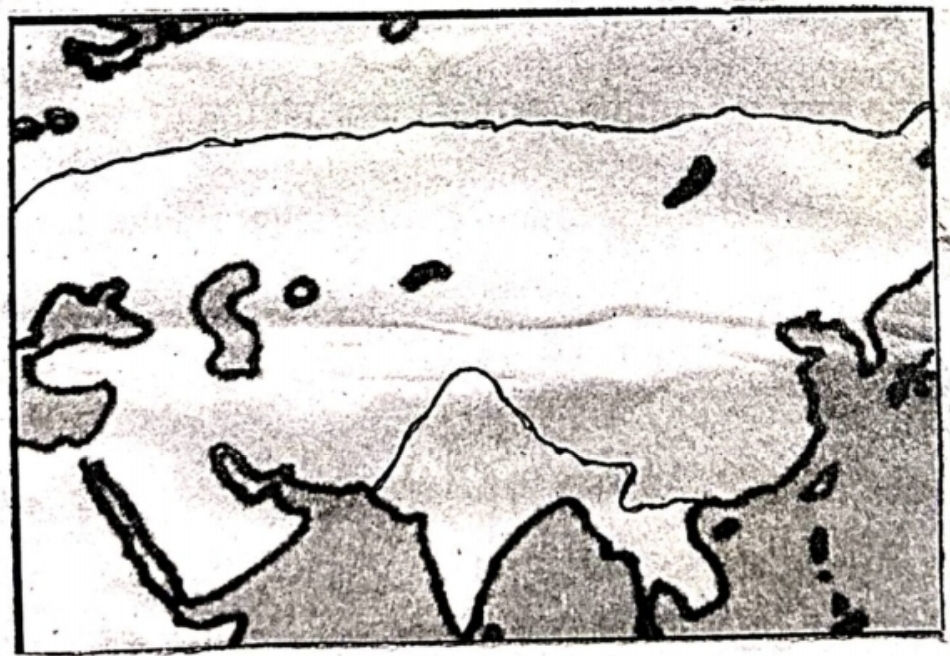
(A) Baghdad
(B) Moscow
(C) Merv Or Karakorum
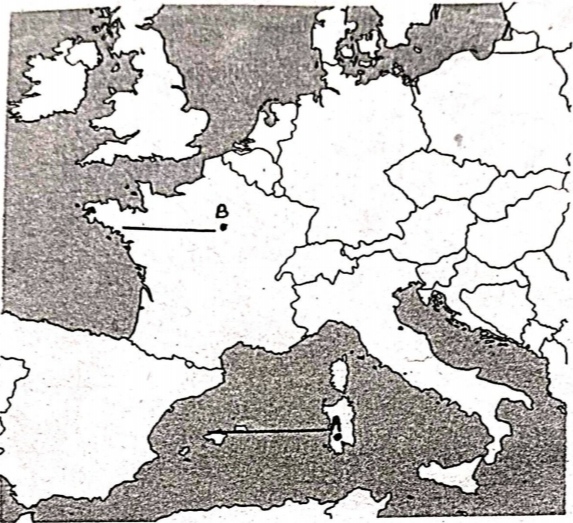
The places marked on the map are:
- A: The island of Sardinia, which is part of Italy.
- B: The region of Brittany, located in France.
AI responses may include mistakes.
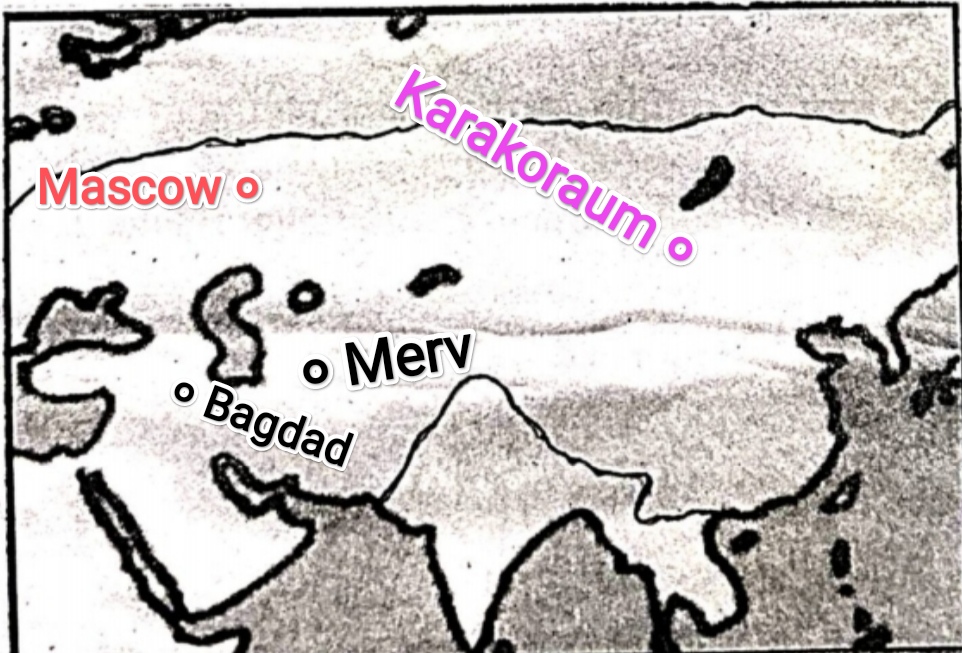
NOTE: The following questions are only for visually compared candidates in lieu of question
Q 34.1 Which era is indicated for the history between fifth to fifteenth century Europe? (1 mark)
Answer:
The period between the fifth to fifteenth century in Europe is known as the Medieval Era or Middle Ages.
Q 34.2 What was the initial name of ‘France’? (1 mark)
Answer:
The initial name of France was Gaul.
Q 34.3 When was Genghis Khan born? (1 mark)
Answer:
Genghis Khan was born in 1162 CE.
Q 34.4 What were the underground canals in arid Iranian Plateau called? (1 mark)
Answer:
The underground canals in the arid Iranian Plateau were called Qanats.
Q34.5 What is the meaning of the word ‘Nomadic’? (1 mark)
Answer:
The word ‘Nomadic’ means wandering people who move from place to place in search of food, water, and pasture instead of living permanently in one location.







